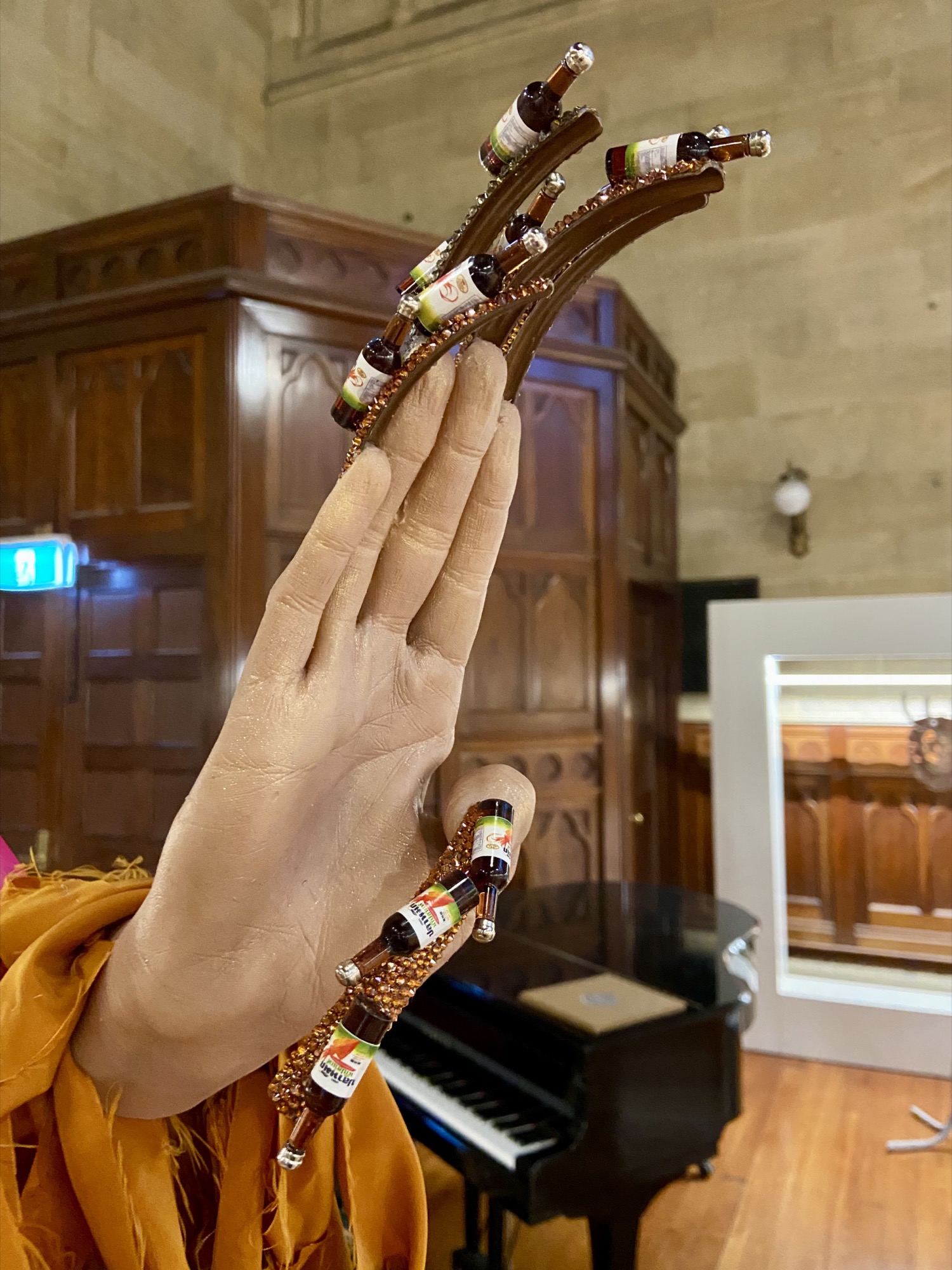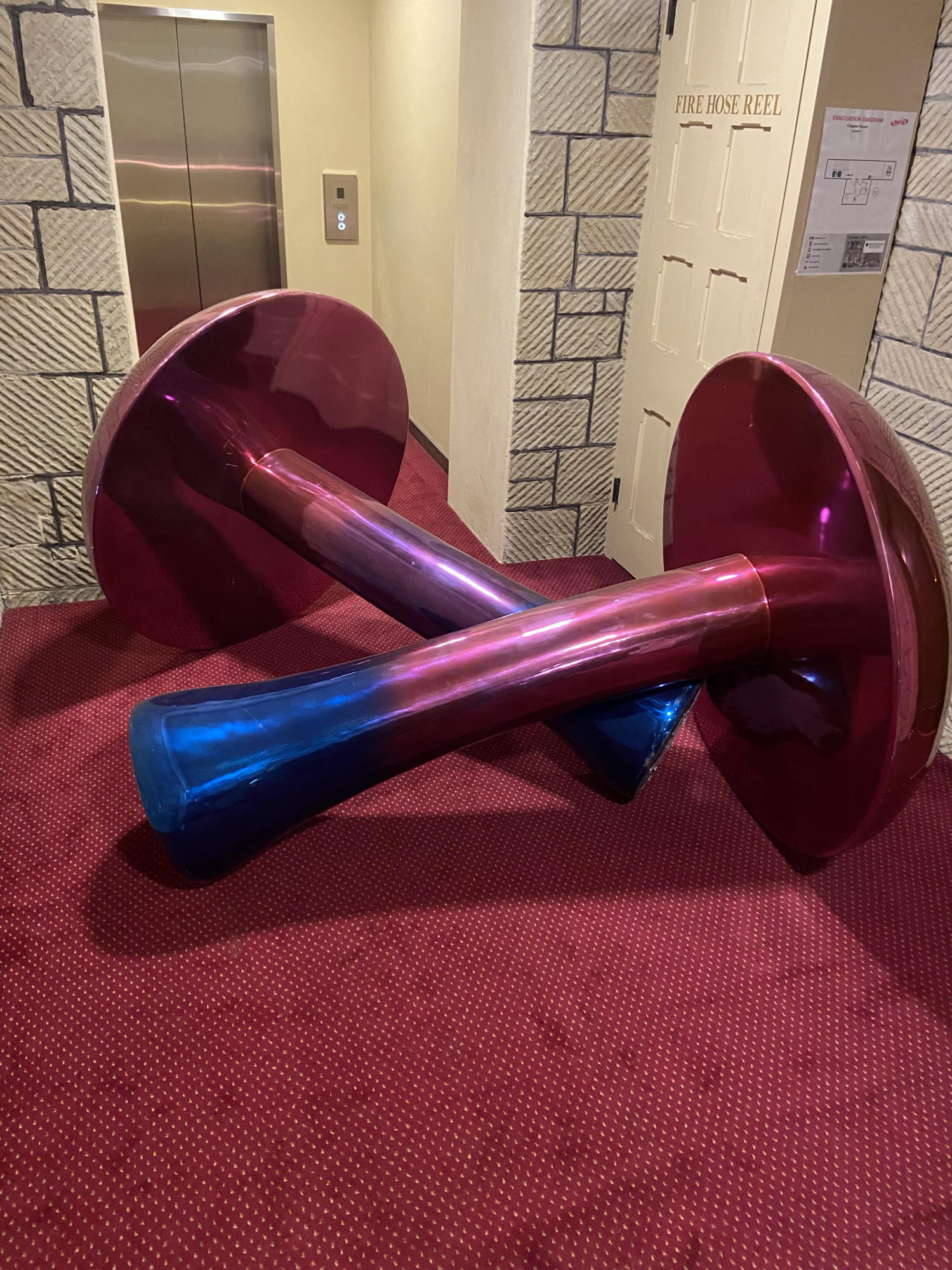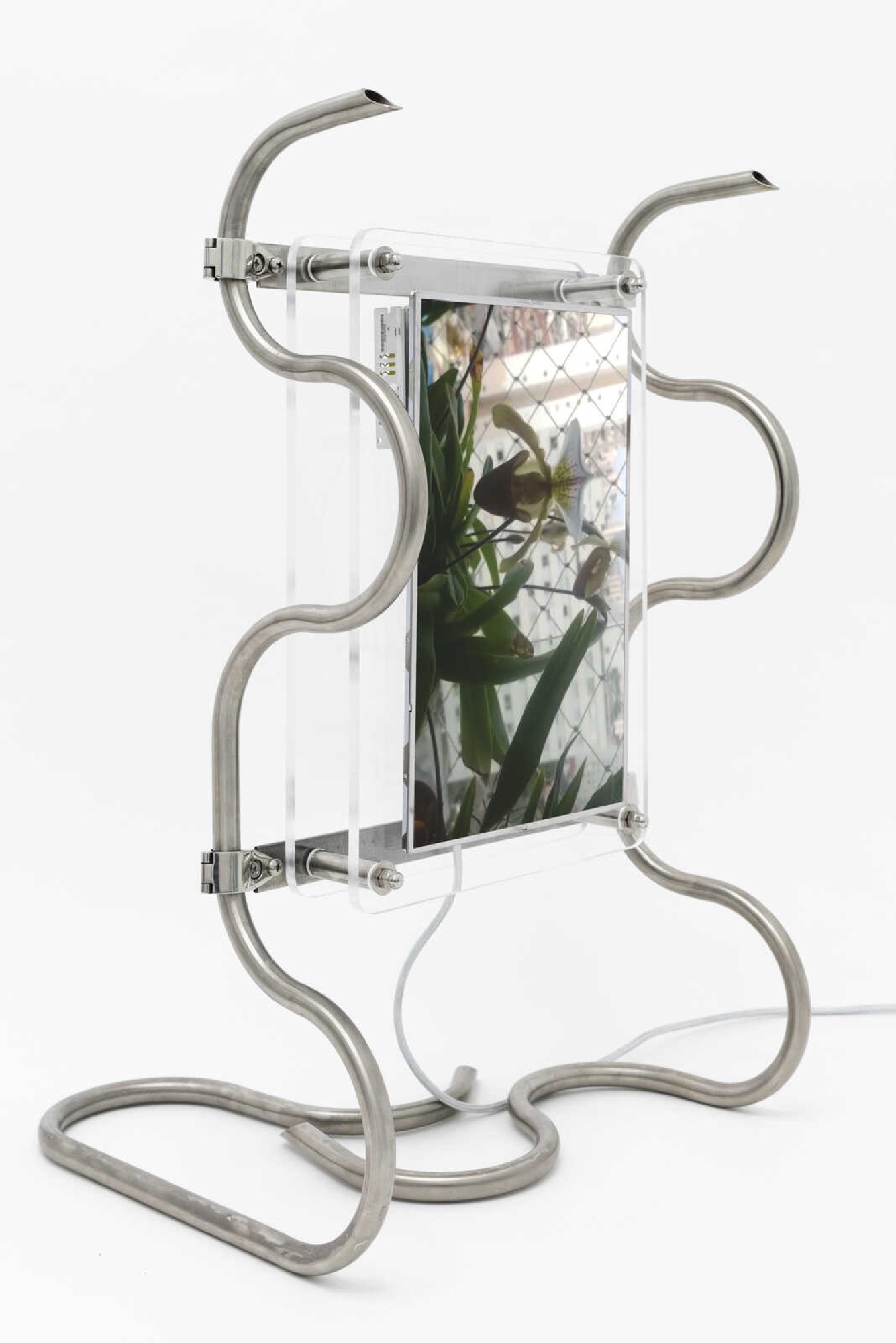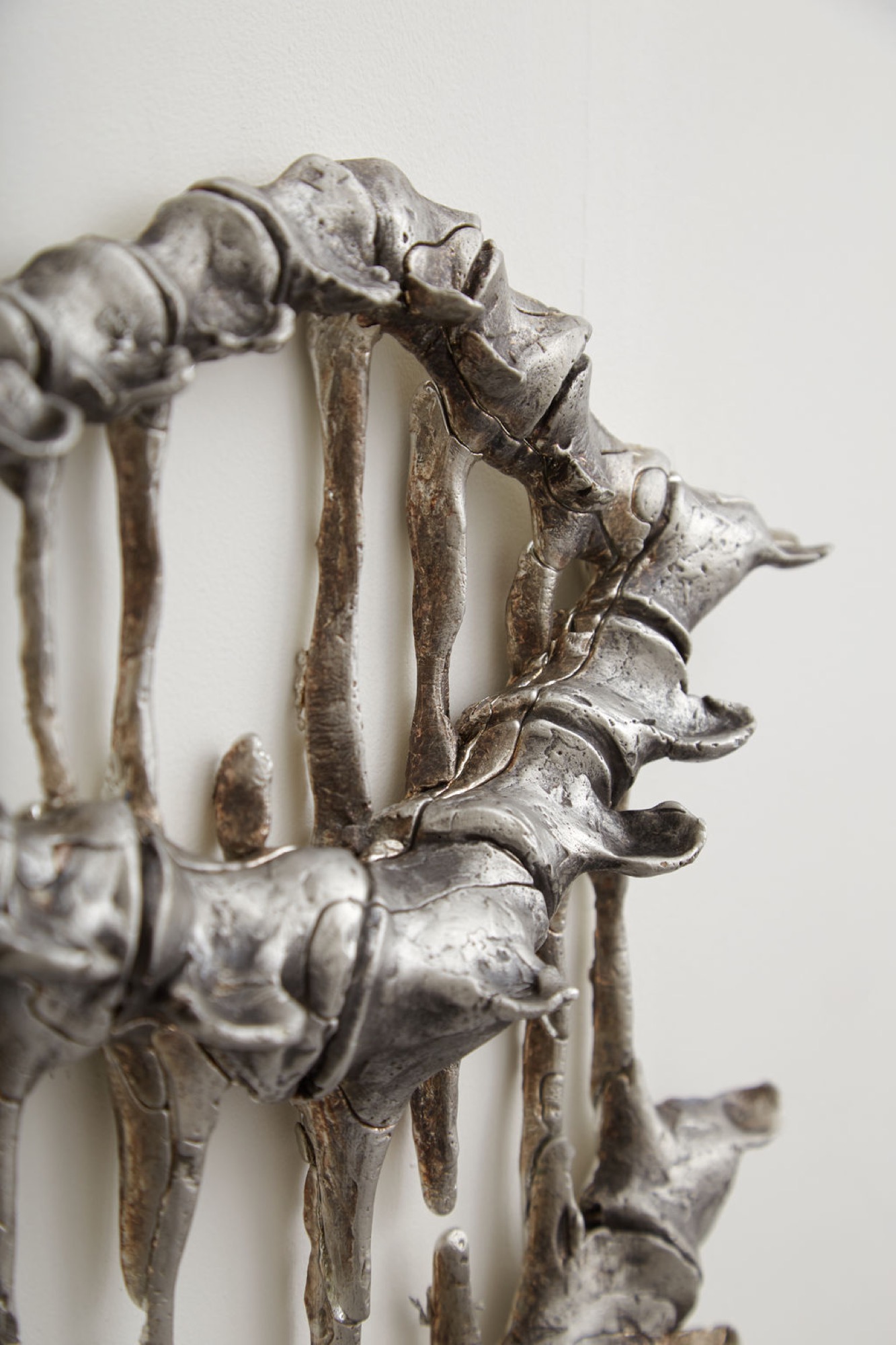Spring1883
Audrey Schmidt and Paris Lettau
Help! We’re lost and can’t tell the shop fronts from this Spring1883 sputnik. It’s caught in the orbit of ALPHA60, punctuated by champagne, cops and QR codes. Gone is the Windsor Hotel’s renaissance-revivalism and grimy opulence, once Spring’s point of difference from those other humdrum art fairs. That was a place where collectors saw how their purchases might look next to drapery, side tables and bed linen. Spring1883 has moved from one Victorian-era setting to another: we’re in the light-flooded and pointy-vaulted Chapter House of St Paul’s gothic-revivalism down on Flinder’s Lane, today housing a store that dresses all Melbourne’s 30-something arts workers in demure linen a-line pinafores, sack-dresses and culottes. The mood is auspicious.

But the cathedral-cum-retail setting is well-adapted to the art fair. Change rooms and designer clothing racks have been easily converted into boutique gallery booths, garments replaced with works of art. In one case, it’s ALPHA60 merchandise itself: their series of printed throw-rugs made in collaboration with Patricia Piccinini are given pride of place both in the centre of the hall and draped over a fancy recliner at the entrance.
Next to Piccinini, Perth-based Nathan Beard has a large Limp-Wristed Gesture (ii) (2020). Elegant hands and curly acrylic nails are appended to sinewy steel limbs, suggestive of the Thai finger dance ฟ้อนเล็บ (fon lep). They are gilded with miniature Squid-brand fish sauce bottles.

Beard’s gallery, FUTURES, newly minted by Zara Sigglekow (previous gallery manager at Neon Parc) and Steven Stewart, has done well to keep with the site-specific brief of Spring, albeit practically without notice. Eric Demetriou made a couple of slightly panicked responses to the Chapter House that worked. The Folded Piano (2014–2021)—the remains of a woodchipped piano—sat inside the seat of the Chapter’s ebony Yamaha grand. In the stairwell leading into the hall were his beaten 44-gallon drums, titled Bunghole (2013–ongoing). One flight of stairs down are two shiny Koons-esque mushroom sculptures, but those just turned out to be a couple of serendipitously placed old City of Melbourne Christmas decorations. The rest of FUTURES is like a cabinet of curiosities, a nineteenth-century arcades project: gooey fluorescent pieces by Matthew Harris; a long and low plinth displaying bits and bobs from Lara Chamas; there’s various imprint works from Hootan Heydari; and several paintings by the one Gen Z we identified, Matilda Davis, who, like Sigglekow, hails from the elder Neon Parc.

Also nestled suggestively into the changerooms are Blackartprojects’ selection of works, which straddle the virtual and the physical. Of particular interest to us are Tristan Chant’s tapestry works made with materials mined from various online and offline sources. One, Hot Taste (2021), features a babe on a birdhouse getting head from a dude she holds to her pussy at gunpoint; it reads “In case of hot taste break open”. The gallery manager loved this one.

Further down the hall is another of Melbourne’s younger commercially-footed galleries, Haydens. Amalia Lindo’s The Cloud is of the Earth features prominently. For the work, the artist has engaged the global task-based gig-economy workforce of Amazon Mechanical Turk (MTurk). The name ominously references the eighteenth-century hoax whereby a chess-playing machine touted to be an automaton was actually operated by a human chess master hiding inside the mechanical illusion.
The three-hundred online workers commissioned by Lindo respond to the Human Intelligence Task (HITs) by submitting short videos of personal significance from their mobile phone archives. Edited by Lindo into four video installations, the liquid-crystal display panels each sit between acrylic perspex held upright by wavy, manipulated stainless steel tubes. As the title suggests, these works ground and solidify the illusive, gaseous “cloud” with all the real-life physicality of server centre geopolitics and human captchas.

Adjacent to Lindo, Jordan Halsall speaks to the same paradox. Six hats sat spectrally on 3D-printed hat racks. Hats made from wheatgrass grown under the artist’s desk, with the heat of his computer accelerating the process the longer he worked at it. The wall works (laid flat), named Free your body are made from a bootleg Soylent recipe found on the Complete Foods forum where people attempt to live off seven ingredients for around $2 per day. Life hacks. Human captchas.
The tenor is not dissimilar across the road. Spring1883 continues at another satellite all the way up on level 8 of the Nicholas Building in CAVES’ intimate showing of Ruby Brown, Noriko Nakamura, Inbal Nissim and Bronte Stolz. (What role could Spring1883 play in the save the Nicholas Building campaign by the way?) Spinal Catastrophism (2021) by Stolz reflects the steeply pointed spinal-like spires of St Paul’s Cathedral still visible out the window. The work’s title references the esoteric book of the same name that draws on cryptic inclinations of J. G. Ballard, Georges Bataille, William Burroughs, André Leroi-Gourhan, Elaine Morgan, and Friedrich Nietzsche. Stolz speaks to existential trauma and apocalyptic consciousness drawing on a core idea of spinal catastrophism that historical progress is the unforeseeable result of cataclysmic disaster.

It’s odd that Soylent, the real-life meal replacement company founded in 2014, took their name from Harry Harrison’s ecological dystopian thriller/sci-fi Make Room! Make Room! (1966). In the 1973 film-version Soylent Green, Soylent is revealed to be made from human corpses, and the homes of the elite feature sex slaves who are referred to as furniture and wait on their masters. Whose taste buds are they trying to inspire? Is this hyperstition, sadistic corporate marketing, or both?
Our reality is the dystopian future of Soylent Green—dying oceans, rising temperatures, pollution, poverty, overpopulation and depleted resources blah blah. And, like Soylent Green, the works at Haydens and CAVES show the artificial, the cloud etc. to be driven by human flesh.
Tiresomely accustomed to digital programs, it’s easy for us to forget that these too are propped up by human labour/HITs on the ground. In this case, it’s the triple-over-work of artists and arts workers coming up with Covid-19 Sample Space experiments (aka CovidSafe plans), forced to make several plans all at once: an if-all-goes-well plan, an if-all-else-fails plan and an if-it-all-goes-to-shit plan. The latter plan is now activated. Spring1883 is viewable on Artsy “from the comfort” of your own home.
Audrey Schmidt and Paris Lettau are contributing editors of Memo Review


